Book review: Practicing Stalinism: Bolsheviks, Boyars, and the Persistence of Tradition
By Sarah J Young, on 9 May 2014
 Andy Willimott is fascinated by a lively study of Russia’s patrimonial practices and personalization of power: J. Arch Getty’s Practicing Stalinism: Bolsheviks, Boyars, and the Persistence of Tradition (New Haven: Yale University Press, 2013).
Andy Willimott is fascinated by a lively study of Russia’s patrimonial practices and personalization of power: J. Arch Getty’s Practicing Stalinism: Bolsheviks, Boyars, and the Persistence of Tradition (New Haven: Yale University Press, 2013).
Recent developments in Ukraine and Crimea have raised a number of questions about Russia and her political machinations. Some of the most perceptive reports have noted that Vladimir Putin’s inner circle, his decision-making core, appears to have shrunk or concentrated over recent months; now centring around a loyal contingent of hardliners, including friends and former classmates of Russia’s über male leader dating back to his years at the KGB Higher School in Leningrad. The implication being that where Putin once acted as a mediator between the different factions of his power network, those that owed their position and/or wealth to his patronage, he is currently aligning himself with the siloviki (‘strong ones’) – formed predominantly from his connections with former Soviet security personnel, many of whom tend to consider the fall of the USSR as a national disaster for Russia and continue to maintain genuine suspicion of the West.
These unspoken connections and informal networks of power are key to understanding the various twists and turns of Russian policy. Russia is a country where institutions often seem to matter less than clientism. The functioning and historic links of network-based governance forms the focus of J. Arch Getty’s latest book, Practicing Stalinism: Bolsheviks, Boyars, and the Persistence of Tradition.Here he argues that while we must acknowledge distinct periods and breaks in history, we should not ignore the persistence of certain political practices. It is striking, suggests Getty, that despite various efforts to introduce rule-bound bureaucracy and formal systems of authority, personalised structures remain integral to Russia’s political operations. ‘The clientism of rulers Khrushchev, Brezhnev, and Putin’, notes Getty, recall ‘patterns not only under Stalin but from the nineteenth century and earlier’ (p. 4). Where the history of ‘Great Men’ once dominated, Getty seems to be saying, we now attribute too much to the power of ideas over habitus and practice. This book challenges reductive readings of Weber that emphasise the distinction between premodern and modern. ‘Modern ideology’, stresses Getty, ‘does not guarantee modernity’ (p. 21). Instead, the Russian example seems to support the notion that old and new – the residual and the emergent – will often intersect, together forming the world around us. Stalinism – no exception – is thus presented as a product of modern socialism and traditional patrimonial structures.
Getty’s opening two chapters provide a thematic overview of Russian political conventions. He uses the examples of petitioning, patron-anointed awards, kinship, and personality cults to highlight the ‘deep structures’ and ‘personalisation’ of Russian politics (p. 25). Not without provocative intent, some of these practices are traced back to 16th-century Muscovy. Be it a letter sent to a Grand Prince or the voice of a citizen partaking in one of Putin’s televised call-in sessions, Getty notes the same patrimonial language and understanding of power. Typical rhetorical features and the formula for redress include fulsome salutations, emphasis of the subject’s lowly position, the faceless nature of their injustice (the improper workings of noble or bureaucratic systems), and the notion that justice is ‘a gift based on mercy and power’ (p. 33). This speaks to the Russian tradition of viewing the tsar as Batiushka (‘little father’), an omnipotent yet just figure not associated with daily travails and the failings of government; a caring father that would solve all problems, if only he were made aware of them! Getty demonstrates that the form and content of Soviet-era letters, with their appeals to ‘Kindred Father Iosif Vissarionovich [Stalin]!’ (p. 28), often exhibited the same characteristics as their pre-revolutionary counterparts.
Likewise, we are shown that the Bolsheviks were not able to escape traditional Russian assumptions about governance. From their roots in the political underground of late imperial Russia, the Bolsheviks operated through loyal connections and local associations. Despite Lenin’s attempts to establish a new rational mechanism of government in 1917 (he even suggested the German Post Office as an example of a modern bureaucratic structure), the Old Bolsheviks, those with experience of clandestine politics and pre-revolutionary habits, continued to exercise power through established patronages. Again, Getty cites comparisons with Muscovy, suggesting that the Old Bolsheviks resembled early Russian boyars (barons or nobles), who, like little tsars, stood atop a patrician network of clients, relatives, and supporters. This was a system of who you know, which revolved around loyalty, protection, and the physical embodiment of power within individuals. To get things done in medieval Russia one had to mobilise these networks, invoking the implicit promise of reciprocal favour and greater proximity to power. The Bolsheviks were not unaware of these parallels. As Nadezhda Mandelshtam recalled, ‘the [Soviet] state encouraged people to behave like boyars in medieval Russia who fought each other over their place at the Tsar’s table’ (p. 53). (more…)
 Close
Close





